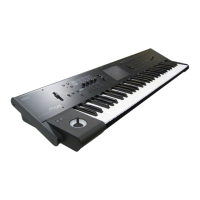PROG P2: OSC/Pitch 2–1: OSC1 Basic
21
PROG P2: OSC/Pitch
These pages control the first and most basic elements of
sounds: the Multisamples that the oscillators play, and the
pitch at which it plays them. For instance, you can:
• Select Multisamples for Single and Double Programs, or
Drum Kits for Drum Programs.
• Set up velocity splits, crossfades, and layers for Single
and Double Programs.
• Set the basic pitch of the sound, including the octave,
fine tuning, and so on.
• Control pitch modulation using a variety of controllers
such as LFO, pitch EG, and the joystick.
Note that when the Oscillator Mode is set to Single or
Drums, only Oscillator 1’s filters are active; the pages for
Oscillator 2’s filters will be grayed out.
2–1: OSC1 Basic
Program’s sounds are based on multisamples, and this page
lets you set up all of the basic multisample-related settings.
Among other things, you can:
• Select Multisamples for the Oscillator (in a Single or
Double Program), or select the Drum Kit for a Drum
Program
• Set the Oscillator’s basic pitch
• Create velocity splits and crossfades between
Multisamples
2–1a: OSC1 Multisample
This setting will depend on the Oscillator Mode setting.
If it is Single or Double, each oscillator can use up to four
multisamples. In Drum mode, there is one Oscillator, and it
plays a single Drum Kit.
Multisamples, and Drum Kits
Multisamples and Drum Kits allow you to play samples in
different ways.
•Multisamples lay out one or more samples across the
keyboard. For instance, a very simple guitar
Multisample might have six samples–one for each string.
•As the name suggests, Drum Kits are optimized for
playing drum samples.
Velocity splits, crossfades, and layers
As mentioned above, unless you’re in Drum mode, each
Oscillator has four velocity zones, named MS1 (High)
through MS4 (Low). Each of these zones can play a
Multisample, and has separate settings for Level, Start
Offset, and so on.
Each of the zones can fade into the next, to create smoother
velocity transitions. Zones can even be layered together, two
at a time.
You can stack a maximum of two velocity zones, causing
two samples to sound simultaneously (layering). You can
also use velocity to smoothly fade between the samples of
these two zones (velocity crossfading).
“Oscillator Mode” Single, Double
MS1 (High)
These are the settings for the first and highest velocity zone.
If you want to create a simple setup with only a single
Multisample, just set up MS1 as desired, and then set the
Bottom Vel. (Bottom Velocity) to 1 and the Xfd (Crossfade
Range) to Off.
Multisample On/Off [Off, On]
Specifies whether the MS1 multisample will sound.
It will sound if this is On (checked).
Bank [Mono, Stereo]
This is displayed if Multisample On/Off is On.
You can choose between looking at mono and stereo
Multisamples. Note that stereo Multisamples will require
twice as many voices as mono Multisamples.
Mono: Internal monaural multisamples.
Stereo: Internal stereo multisamples.
Multisample select [List of Multisample]
This specifies a multisample for MS1.
Some multisamples have an upper limit; notes played
above that limit will not sound.
When you press the Multisample Select popup button, the
multisample list will appear, allowing you to select a
multisample from the list.
Use the tabs to select a category, and select a multisample
within the category. Press the OK button to confirm the
selection, or the Cancel button to cancel.
If Bank is set to RomM, the list shows all of the mono
Multisamples in the Bank. If the Bank contains stereo
multisamples, you’ll also see the left and right channels as
separate, mono multisamples, with –L and –R appended to
the end of the name.
If Bank is set to RomS, only stereo multisamples will be
shown.
Rev (Reverse) [Off, On]
This plays the selected multisample in reverse without
looping it.
2–1a
2–1
Menu

